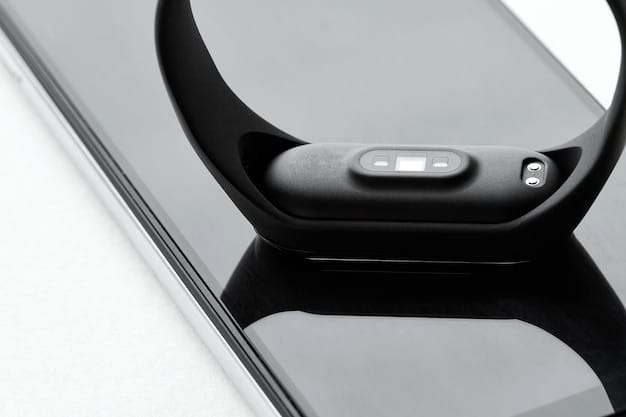Smartwatch Showdown: Which Fitness Tracker Reigns Supreme in 2025?

The Smartwatch Showdown: Which Fitness Tracker Reigns Supreme in 2025? article rigorously analyzes leading models, assessing their advanced health monitoring, battery life, design, and overall ecosystem integration to determine the top contenders for fitness enthusiasts and tech-savvy consumers in the evolving wearable technology landscape.
In the rapidly evolving world of wearable technology, fitness trackers have transitioned from niche gadgets to essential companions for health-conscious individuals. This Smartwatch Showdown: Which Fitness Tracker Reigns Supreme in 2025? delves into the contenders vying for the top spot, examining their features, innovations, and overall impact on user well-being.
The Evolution of Wearable Tech: From Step Counters to Health Hubs
The journey of fitness wearables has been nothing short of remarkable. What began as simple step counters has blossomed into sophisticated health monitoring devices, seamlessly integrating into our daily lives. In 2025, these devices are no longer just tracking steps or calories; they are becoming crucial hubs for comprehensive health data, offering insights that were once exclusive to medical professionals.
The transition reflects a growing demand for personalized health management and preventive care. Users expect more than just raw data; they seek actionable insights and predictive analytics that can genuinely improve their quality of life. This shift has pushed manufacturers to innovate rapidly, leading to devices capable of advanced biosensing and data interpretation.
Advanced Biosensing Capabilities
Modern fitness trackers are equipped with an array of sensors that go far beyond the conventional accelerometer. These include:
- ECG/EKG Sensors: For on-demand electrocardiogram readings to detect irregular heart rhythms.
- Blood Oxygen (SpO2) Monitoring: Assessing oxygen saturation levels, crucial for sleep health and respiratory conditions.
- Skin Temperature Sensors: Providing baselines for detecting fever or monitoring menstrual cycles.
- Advanced Heart Rate Tracking: Utilizing optical sensors for continuous, accurate heart rate monitoring during various activities and rest.
The integration of these advanced biosensors has transformed fitness trackers into proactive health tools. They can alert users to potential health issues, encourage lifestyle adjustments, and even facilitate early diagnosis, bridging the gap between consumer electronics and clinical monitoring. The data collected by these devices offers a longitudinal view of health trends, empowering individuals to take control of their well-being.
As we move further into 2025, the trend is towards even more precise and non-invasive monitoring. Imagine devices that can predict illness before symptoms appear, or offer real-time nutritional guidance based on metabolic readings. The convergence of AI, miniaturization, and sensor technology promises a future where our wearables are truly personal health guardians.
This section underscores the rapid technological advancements that have redefined what a fitness tracker can be. From rudimentary activity logging to comprehensive health analysis, the evolution is a testament to the industry’s commitment to user welfare and proactive health management.
Key Contenders: Who’s Leading the Pack in 2025?
As 2025 unfolds, several key players dominate the fitness tracker market, each bringing unique strengths and ecosystems to the table. The competition is fierce, with innovation driving continuous improvements in functionality, design, and user experience. Understanding their distinct features is crucial for discerning consumers.
The leading brands have invested heavily in research and development, striving to offer a blend of cutting-edge technology and user-friendly interfaces. Their offerings reflect a deep understanding of consumer needs, from casual fitness enthusiasts to dedicated athletes. The choice often comes down to individual priorities: is it battery life, advanced metrics, or seamless integration with other devices?
Apple Watch: The Ecosystem Powerhouse
The Apple Watch continues to be a benchmark for smartwatches, excelling in seamless integration within the Apple ecosystem. Its comprehensive health suite, including advanced ECG, blood oxygen, and temperature sensing, makes it a formidable health companion. Its robust app store and cellular capabilities further enhance its versatility.
Prospective users often value the Apple Watch for its reliability and polished user interface. The Emergency SOS and Fall Detection features provide an extra layer of security, making it appealing to a broad demographic. Furthermore, the extensive range of fitness programs and guided workouts available through Apple Fitness+ add significant value for users committed to an active lifestyle.
Garmin: The Athlete’s Choice
Garmin remains the undisputed leader for serious athletes and outdoor adventurers. Known for its exceptional GPS accuracy, long battery life, and in-depth performance metrics, Garmin devices are built for endurance. Their specialized models cater to runners, cyclists, swimmers, and multisport athletes with unparalleled precision.

Garmin’s ecosystem, while not as broad as Apple’s, is highly focused on athletic data analysis. Features like Body Battery, Training Status, and Recovery Time provide actionable insights that help athletes optimize their performance and prevent overtraining. The durability and rugged design of many Garmin watches also make them ideal for extreme conditions.
Samsung Galaxy Watch: Android’s Flagship
For Android users, the Samsung Galaxy Watch series offers a compelling alternative, especially with its integration with Samsung Health and Google’s Wear OS. These watches boast vibrant displays, extensive health tracking features, and a growing ecosystem of third-party apps. They are often praised for their stylish designs and customization options.
The Galaxy Watch models have made significant strides in health monitoring, incorporating features like BIA (Bioelectrical Impedance Analysis) for body composition readings alongside ECG and blood oxygen. Their compatibility with a wide range of Android smartphones makes them a versatile choice for users outside the Apple ecosystem.
Fitbit: The User-Friendly Health Tracker
Fitbit continues to be a popular choice for those seeking a user-friendly and motivational health tracking experience. While perhaps not as feature-rich as some high-end smartwatches, Fitbit excels in daily activity, sleep tracking, and stress management. Their focus on holistic well-being and community features resonates with many users.
Recent Fitbit models, now under Google’s ownership, have started to incorporate more advanced health sensors, bridging the gap between activity trackers and full-fledged smartwatches. Their intuitive app and comprehensive data presentation make health tracking accessible and engaging for everyday users. The combination of hardware and software designed for simplicity makes Fitbit an excellent entry point into wearable technology.
Each of these brands brings a unique value proposition, catering to different segments of the market. The choice ultimately depends on individual priorities, whether it’s raw athletic performance data, seamless smart features, or comprehensive health insights tailored for daily use.
Advanced Health Monitoring: Beyond the Basics
The promise of personalized health has never been more tangible than with the current generation of fitness trackers. They have transcended basic activity logging to become sophisticated health monitors, offering insights that were once the domain of medical diagnostic equipment. This evolution is driven by miniaturization, improved sensor accuracy, and intelligent algorithms.
In 2025, advanced health monitoring extends far beyond counting steps or measuring heart rate. Devices are now capable of providing data points that can reveal underlying health conditions, track trends over time, and even offer predictive recommendations for maintaining good health. This shift makes these wearables invaluable tools for proactive health management.
Understanding ECG and Heart Health
Electrocardiogram (ECG) functionality in smartwatches allows users to take on-demand readings of their heart’s electrical activity. This feature is instrumental in detecting signs of atrial fibrillation (AFib), a common form of irregular heart rhythm that can lead to strokes if left undiagnosed. Early detection through a wearable can prompt users to seek medical attention, potentially saving lives.
The convenience of an ECG on your wrist means that unusual symptoms or concerns about heart health can be investigated immediately, without waiting for a doctor’s appointment. While not a substitute for clinical diagnosis, these readings provide valuable preliminary data and encourage timely consultation with healthcare professionals.
Sleep Tracking and Recovery Insights
Comprehensive sleep tracking is another cornerstone of advanced health monitoring. Modern fitness trackers can analyze sleep stages (REM, deep, light), detect disturbances, and even monitor blood oxygen saturation during sleep for signs of conditions like sleep apnea. Beyond just tracking, many devices now offer personalized insights and recommendations for improving sleep quality.
Recovery metrics, often linked to sleep quality and activity levels, are increasingly sophisticated. Devices estimate recovery time needed after workouts, analyze heart rate variability (HRV) as an indicator of stress and recovery, and provide a “readiness score” to guide daily activity levels. These insights help users balance training intensity with proper rest, optimizing performance and well-being.
Stress Management and Mental Wellness
Beyond physical health, wearables are also venturing into mental well-being. Built-in stress tracking often utilizes heart rate variability and skin conductance to estimate stress levels throughout the day. Many devices offer guided breathing exercises or mindfulness prompts to help users manage acute stress.
This holistic approach to health acknowledges the strong connection between mental and physical well-being. By providing tools for stress awareness and management, fitness trackers are becoming comprehensive partners in promoting overall health, addressing aspects previously overlooked by traditional activity monitors.
The continuous innovation in health monitoring features is transforming wearables into indispensable health tools. They empower users with data, facilitate early detection, and encourage a proactive approach to maintaining both physical and mental health, cementing their role as essential health companions.
Battery Life and Performance: The Endurance Test
In the realm of wearable technology, battery life often emerges as a critical differentiator. A feature-rich device is only as good as its ability to last, especially when comprehensive health tracking and smart functionalities are in constant use. Users demand devices that can keep pace with their active lifestyles without constant recharging.
The balance between powerful performance and extended battery life is a continuous challenge for manufacturers. As sensors become more sophisticated and displays more vibrant, the power demands increase. However, advancements in low-power chipsets, efficient operating systems, and larger battery capacities are pushing the boundaries of what’s possible in 2025.
Optimizing for Longevity
Different models employ various strategies to optimize battery performance. Devices with transflective displays, for instance, consume less power in bright sunlight compared to always-on OLED screens. GPS usage, continuous heart rate monitoring, and cellular connectivity are among the biggest battery drains, leading manufacturers to offer customizable power modes.
For some high-end fitness trackers, particularly those geared towards outdoor adventures or multi-day athletic events, battery life can extend to weeks, thanks to larger power cells and specialized low-power modes that prioritize essential tracking over smart notifications. This makes them ideal for extended trips or expeditions where charging opportunities are scarce.
Performance Under Pressure
Beyond simple longevity, the performance of a fitness tracker under intense usage conditions is paramount. This includes responsiveness of the interface, accuracy of sensor readings during strenuous activity, and stability of connectivity. A laggy interface or inaccurate data during a critical workout can severely diminish the user experience.
Processors in 2025 wearables are designed to handle complex data processing on-device, enabling faster insights and more responsive applications. This includes AI-powered algorithms that personalize coaching and analyze biometric data in real-time. The goal is to provide a seamless and uninterrupted experience, whether tracking a marathon or simply checking notifications.
Ultimately, the ideal battery life and performance depend on the user’s specific needs. A casual user might prioritize a sleek design and smart features over multi-week battery life, while an ultra-marathoner would choose endurance above all else. Manufacturers are increasingly offering a range of models, allowing consumers to select devices that perfectly align with their usage patterns and performance expectations.
Design and Comfort: More Than Just a Gadget
In 2025, a fitness tracker is no longer just a utilitarian gadget; it’s a statement of personal style and an extension of one’s identity. Design and comfort have become critical factors influencing purchasing decisions, rivaling even advanced technical specifications. Wearables need to look good and feel good, whether worn during a workout, at a business meeting, or while sleeping.
Manufacturers are acutely aware of this shift, investing heavily in aesthetics, material science, and ergonomic design. The goal is to create devices that are both highly functional and seamlessly integrate into diverse lifestyles, moving beyond the realm of purely athletic gear to become fashionable accessories.
Materials and Craftsmanship
The choice of materials plays a significant role in both comfort and perceived quality. Premium fitness trackers now frequently feature:
- Aerospace-grade Aluminum and Titanium: For lightweight durability and a sophisticated finish.
- Sapphire Glass: Offering superior scratch resistance for displays.
- High-quality Silicone and Leather Bands: Providing comfort for all-day wear and suitability for various occasions.
- Ceramic Backs: Enhancing sensor contact with the skin and providing a hypoallergenic surface.
These material choices not only contribute to the device’s resilience but also elevate its aesthetic appeal, allowing it to transition effortlessly from a gym session to a formal event. The focus on craftsmanship ensures that these devices are not just electronics but miniature pieces of engineering art.
Ergonomics and Wearability

Comfort is paramount for a device worn continuously. Ergonomics dictate how a watch sits on the wrist, how its weight is distributed, and whether it causes irritation over prolonged periods. Designers are striving for slimmer profiles, lighter weights, and contours that conform naturally to the wrist.
The quality of the strap is also crucial. Breathable, flexible materials are essential for fitness use, while easily interchangeable bands allow users to customize their watch for different contexts – a durable silicone band for a run, a stylish leather band for an evening out. The ability to personalize the look and feel through watch faces and interchangeable straps further enhances the appeal.
In essence, the best fitness trackers in 2025 strike a harmonious balance between cutting-edge technology and sophisticated design. They are engineered to perform at the highest level while remaining comfortable, stylish, and adaptable to every aspect of a user’s life, proving that substance and style can coexist beautifully in wearable technology.
Software and Ecosystem Integration: The Seamless Experience
The true power of a fitness tracker in 2025 extends far beyond its hardware capabilities. It resides in the software ecosystem it operates within, and its ability to seamlessly integrate with other devices, applications, and services. A robust, intuitive, and interconnected software experience is what transforms raw data into actionable insights and a mere gadget into an indispensable daily companion.
Users expect more than just data collection; they demand a unified platform where their health metrics, smart notifications, and personalized coaching converge effortlessly. This integration is crucial for fostering long-term engagement and delivering a genuinely holistic view of health and well-being.
Operating Systems and User Interface (UI)
The underlying operating system (OS) of a smartwatch dictates much of its functionality and user experience. Wear OS (Google), watchOS (Apple), and proprietary OSs (Garmin, Fitbit) each offer distinct advantages. A good UI is characterized by its responsiveness, ease of navigation, and clarity of information display.
Features like customizable watch faces, intuitive gesture controls, and clear notifications are vital. Furthermore, the ability of the OS to handle multitasking efficiently—such as tracking a workout while streaming music and receiving calls—speaks volumes about its performance and user-centric design. Voice assistants integrated into the OS also play a pivotal role in hands-free interaction.
App Ecosystem and Third-Party Integration
The richness of a device’s app ecosystem significantly enhances its utility. Whether it’s access to popular fitness apps like Strava, mindfulness applications like Calm, or smart home controls, a strong selection of third-party apps transforms a tracker into a truly versatile smart device. Open APIs (Application Programming Interfaces) allow developers to create innovative tools that leverage the device’s sensor data.
Seamless integration with smartphone apps is non-negotiable. This means easy data syncing, straightforward notification management, and deep customization options accessible from the phone. For many users, the convenience of receiving and responding to messages, managing calls, and controlling music directly from their wrist is a major draw.
Cloud Sync and Data Privacy
Health data generated by fitness trackers is sensitive, making cloud sync and data privacy paramount. Reputable brands ensure secure cloud storage, allowing users to access their historical data and trends across multiple devices. Transparency regarding data usage and strong privacy policies are crucial for building user trust.
The ability to securely share data with healthcare providers, personal trainers, or family members (with explicit consent) adds significant value, facilitating a more connected approach to health management. This balance between data utility and privacy protection is a hallmark of a robust and responsible ecosystem.
In essence, the strength of a fitness tracker in 2025 is increasingly defined by its software and how well it integrates into a user’s digital life. A seamless, intelligent, and secure ecosystem is what truly elevates a good wearable to an essential personal health and productivity tool.
Future Trends and What to Expect from Wearables in 2026 and Beyond
The trajectory of wearable technology suggests a future even more integrated with our health and daily lives. As we look towards 2026 and beyond, several key trends are set to redefine the capabilities and role of fitness trackers, pushing the boundaries of personal monitoring and preventative care. The innovation pipeline is rich with groundbreaking possibilities.
The next wave of wearables will likely be characterized by enhanced sensor accuracy, deeper integration of AI for predictive analytics, and a broader focus on mental and emotional well-being. Miniaturization will continue, leading to more discreet and versatile form factors, perhaps even moving beyond the wrist.
Non-Invasive Glucose Monitoring and Advanced Biosensors
One of the “holy grails” in wearable tech is reliable, non-invasive glucose monitoring. While prototypes exist, widespread, accurate consumer versions could revolutionize diabetes management and general metabolic health. Imagine a wearable that provides real-time blood sugar levels without requiring a finger prick, offering immediate feedback on diet and activity.
Beyond glucose, expect to see integration of even more sophisticated biosensors: real-time blood pressure monitoring from the wrist, continuous hydration sensing, and even early detection of viral infections through changes in a user’s physiological baseline. These advancements will move wearables closer to being personalized diagnostic tools.
Hyper-Personalized AI Coaching and Predictive Health
The role of AI in fitness trackers will transition from data analysis to proactive, hyper-personalized coaching. Based on longitudinal data, AI will be able to predict potential health risks, suggest tailored exercise routines, and optimize dietary recommendations with unprecedented precision. This goes beyond generic advice, offering truly bespoke guidance tailored to an individual’s unique physiology and lifestyle.
Predictive health analytics will become more sophisticated, potentially alerting users to the onset of illness before symptoms become apparent, or identifying patterns that indicate increased risk for chronic conditions. This shift towards anticipatory health management represents a significant leap forward in preventative care.
Seamless Integration with Smart Environments and AR/VR
Wearables will increasingly integrate with smart home ecosystems and emerging augmented/virtual reality (AR/VR) platforms. Imagine your fitness tracker seamlessly adjusting room temperature based on your body temperature during sleep, or guiding you through a virtual workout in an AR environment, with real-time feedback overlaid on your view.
The “Invisible Tech” concept will gain traction, where devices become smaller, less obtrusive, and more naturally integrated into clothing or other accessories. The goal is to make the technology so seamless that it becomes an almost imperceptible part of your existence, quietly working in the background to enhance health and convenience.
The future of wearables is exciting, promising devices that are more intelligent, more integrated, and more capable of delivering truly personalized health insights than ever before. These innovations will solidify the fitness tracker’s role as an indispensable tool for a healthy and connected future.
| Key Aspect | Brief Description |
|---|---|
| 🚀 Evolving Tech | From basic step counters to advanced health hubs with sophisticated biosensors. |
| 💖 Health Monitoring | ECG, SpO2, sleep tracking, and stress management are now standard features. |
| 🔋 Battery Life | Crucial balance between powerful features and device longevity. |
| 🌐 Ecosystem Strength | Seamless integration with apps and a strong OS define user experience. |
Frequently Asked Questions
▼
In 2025, the line between smartwatches and dedicated fitness trackers has blurred considerably. Smartwatches typically offer richer app ecosystems, broader communication features (like cellular connectivity for calls), and more versatile displays for notifications and interactions. Dedicated fitness trackers, while often simpler, excel in specialized health metrics, extended battery life, and often a more focused approach to activity tracking.
▼
The accuracy of health metrics in 2025 smartwatches has significantly improved, especially for features like heart rate, ECG, and blood oxygen saturation. While these devices are not medical-grade diagnostic tools, they provide highly reliable data for general health monitoring and identifying potential irregularities. Users should always consult healthcare professionals for definitive diagnoses based on these readings.
▼
Apple, Garmin, and Samsung are consistently leading in innovation within the fitness tracking space in 2025. Apple excels in comprehensive health features and ecosystem integration, Garmin dominates in sports-specific metrics and battery life for athletes, and Samsung offers a strong Android-compatible option with a focus on holistic health. Fitbit also continues to innovate, particularly in user-friendly daily health and sleep tracking.
▼
Battery life is crucial in 2025 for fitness trackers, particularly given the increased demand for continuous health monitoring, advanced sensor usage, and smart functionalities. A longer battery life ensures uninterrupted tracking of workouts, sleep, and daily activities without constant recharging, providing a more reliable and complete data set for users. It significantly impacts the overall convenience and utility of the device.
▼
Beyond 2025, we can anticipate more advanced and non-invasive health monitoring features in wearables. These include greater accuracy for non-invasive glucose monitoring, real-time blood pressure from the wrist, and potentially continuous hydration sensing. The integration of AI will also lead to more hyper-personalized coaching and predictive health analytics, enabling earlier detection of health issues and more tailored wellness advice.
Conclusion
The Smartwatch Showdown: Which Fitness Tracker Reigns Supreme in 2025? reveals a dynamic and highly competitive landscape where innovation drives continuous advancements. From sophisticated health monitoring to seamless ecosystem integration, top contenders like Apple, Garmin, Samsung, and Fitbit are pushing boundaries, blurring the lines between smartwatches and dedicated fitness trackers. The ultimate choice hinges on individual priorities – whether it’s comprehensive smart features, detailed athletic metrics, or user-friendly daily health tracking. As these devices become increasingly intuitive personal health companions, their role in empowering users with actionable data and fostering proactive well-being is undeniable, promising an even more integrated and intelligent future for wearable technology.





